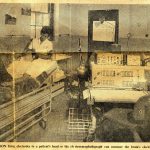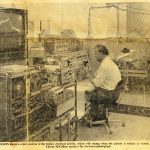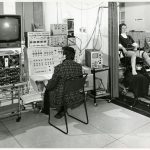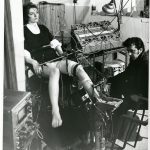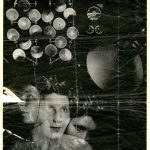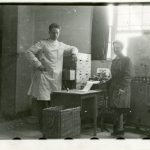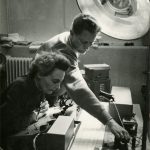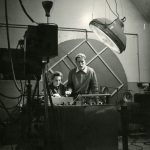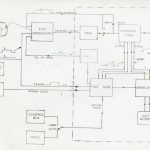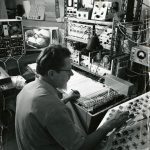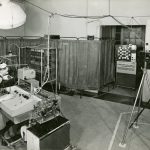Wired-up in white organdie: framing women’s scientific labour at the Burden Neurological Institute
Article DOI: https://dx.doi.org/10.15180/181003
Abstract
The Burden Neurological Institute (BNI) is widely considered one of the central sites in the history of British neuroscience. Founded in 1939 to investigate the anatomy, functions, and disorders of the human brain, the BNI rapidly established a reputation as a world-leading centre of research and expertise. Due to the rich insights offered by the BNI Papers, held in the archives of the Science Museum, London, the work of the BNI has become a popular topic among historians of science and technology. However, one key omission in both the archival record and in subsequent historical accounts has been the BNI’s prominent employment of women as researchers, technicians and laboratory assistants. To address this absence, this article examines the comparatively underutilised photographic collections of the BNI Papers, in which women feature more prominently. However, rather than providing an unproblematic ‘window’ onto the experiences of these scientific workers, this article contends that the photographs in question ‘frame’ women’s labour in particular ways so as to devalue, obscure and erase their contributions to the BNI’s much-lauded achievements. The article considers three such frames: the objectification of women as the subjects, rather than the practitioners, of neuroscientific research; the elision of women’s scientific, domestic, and familial roles; and the visual equation of women’s labour with that of the machine. The article concludes by considering some of the ways in which critiques of visual framing might be integrated into both future historical accounts and museum display practices.
Keywords
Burden Neurological Institute, gender, Neuroscience, photography, women's labour
Introduction: framing women in neuroscientific research
https://dx.doi.org/10.15180/181003/002In the celebratory narratives of twentieth-century neuroscience, the Burden Neurological Institute (BNI) occupies a prominent position. Founded in Bristol in 1939 as an independent research unit, the BNI rapidly established itself as a world-leading centre of expertise in the anatomy, functions, and disorders of the human brain. Within its first two years, the Institute secured its radical credentials by performing Britain’s first trials of electro-convulsive therapy (ECT) and prefrontal leucotomy (lobotomy), before making great leaps forward in fields as diverse as electroencephalography (the recording of the electrical activity of the brain, also known as EEG) and robotic engineering.[1] For many, the BNI’s revolutionary outlook was embodied in its most well-known figure, the neurophysiologist William Grey Walter (1910–1977). Over the years, Walter has been variably portrayed as a genius engineer who recognised the untapped potential of the human brainwave (Bladin, 2006), an amateur roboticist who inaugurated a new age of artificial intelligence research from the confines of his garden shed (Holland, 2003), a maverick scientist who dismayed the academic establishment with his repeated refusals to conform (Hayward, 2001, p 616), and a fair-haired ‘Adonis’ with ‘an eye for the ladies’ (Cooper and Bird, 1989, pp 49–51).
Yet the elision of the BNI’s story with the biography of its most prominent ‘lone male genius’ risks overlooking an intriguing and largely understudied aspect of the Institute’s history: its prominent employment of women as researchers, technicians and laboratory assistants. Between 1950 and 1954, a formative period in the BNI’s burgeoning research programme, 42 per cent of the Institute’s recorded positions were held by women.[2] This figure is particularly striking considering that women constituted 31 per cent of the national workforce during this period and held just 22 per cent of positions within comparable engineering fields (Holloway, 2005, pp 191–197). Furthermore, while many of their counterparts in other scientific workplaces found themselves largely restricted to clerical and administrative duties (Horrocks, 2000, pp 355–361), female staff at the BNI played crucial roles in shaping the Institute’s research agenda. Prominent individuals included psychiatrist Effie Lilian Hutton (1904–1956), the BNI’s first Clinical Director who organised many of its early psychosurgical breakthroughs (Hutton, Fleming and Fox, 1941), radiologist Vivian Joan Aldridge (née Dovey, later Walter, 1915–1980), who collaborated on a number of the BNI’s foundational EEG projects, including the use of the technique to detect subcortical tumours (Walter and Dovey, 1946), and Janet Shipton (née Attlee, 1923–), who co-authored publications on brainwave frequencies and their relation to variations in human personality (Cooper et al, 1957).[3]
Despite these crucial contributions, the voices of female staff are practically absent from the BNI’s historical and archival legacy. This much is evident in the BNI Papers, which, since their donation to the Science Museum, London in 2000, have provided the foundation for the vast majority of historical studies of the Institute and its achievements. Out of the nearly three hundred items of written material that constitute the collection’s main papers, a mere six per cent are derived from female authors. Examining the extensive collection of correspondence, 88 per cent of letters exclusively record communication between men, with just 12 per cent documenting conversations between participants of different genders. The papers do not contain a single instance of communication between two female employees.[4] It is therefore unsurprising that the BNI emerges in most histories as a site of exclusively male scientific enterprise. While these materials offer rich and detailed evidence of male collaborative relationships, right down to debates over what types of nuts and bolts should be used in prototype machines, they offer no such insight into the experiences of women working at the Institute.[5]
There is, however, one section of the BNI Papers in which women are not chronically underrepresented: its small collection of photographs and press cuttings. Here, women appear in 47 per cent of images; furthermore, in ‘portrait’ style photographs, featuring individual members of staff rather than mixed groups, women actually constitute the majority.[6] As such, the visual materials of the collection, while much fewer in number than their written equivalents, provide a representation of women that is at least quantitatively equivalent to their presence within the BNI’s laboratories. It might be tempting, therefore, to view photographic images of the BNI as a tool through which the masculine domination of the archival record can be subverted: a ‘window’ through which one might access a hidden history of women’s scientific achievements.
However, to embrace photographs in this way – as superior and unproblematic tools of historical empowerment – would be to overlook a critical tradition of scholarship established in the works of Susan Sontag (1977), John Berger (1980) and Allan Sekula (1981; 1982) among others. Collectively, these critiques rejected notions of the photograph as a direct, neutral and disinterested imprint of reality, and instead advocated for a more rigorous deconstruction of photographic images to reveal their hidden layers of political, social and cultural meaning (see also Flusser, 1983; Tagg, 1988). These approaches to photography have intersected powerfully with historical critiques of gender, with scholars such as Abigail Solomon-Godeau (1991), Carol J Williams (2003), and Laikwan Pang (2007) exploring the critical role of photographic images in the production and naturalisation of gender norms.
Over the past decade, historians of photography have sought to adapt and nuance these deconstructionist approaches, conceptualising photographs not just as politically-charged images but also as physical, material objects with distinctive histories of production, collection, and display (Mitman and Wilder, 2016; Klamm, 2016). This ‘material turn’ in histories of photography has further encouraged scholars to consider not just photographic content – that is, what a photograph depicts – but also, photographic agency: what a photograph ‘does’ in a particular socio-political environment. Within any given space, a photograph might foster a communal sense of identity and purpose (Pollen, 2016), open up spaces for political critique and dissent (Pasternak, 2010; 2013), or stir up visceral, affective and multisensory experiences in its viewers (Edwards, 2010).
These critical analyses of materiality and agency are particularly useful when considering the role of photographs in bolstering the authority of scientific research and its practitioners. Scholars have long recognised the privileged place occupied by photography among other visual tools of scientific proof – such as graphs, diagrams, and models – by virtue of its distinctive claim to truthfulness and universality (Burri and Dumit, 2007). This is particularly pronounced in the modern neurosciences, where ‘photographic’ images of the brain produced via techniques such as positron emission tomography (PET) and functional magnetic resonance imaging (fMRI) have played a vital role in establishing the discipline’s cultural authority over ephemeral domains such as consciousness, selfhood, and the emotions (Rose and Abi-Rached, 2013, pp 65–81). As such, photographs of research practices are not mere reflections of predetermined scientific authority, but rather produce and enact that authority through their creation, circulation and display.
Following these approaches, this article examines the ways in which photographic depictions of women working at the BNI have helped to ‘frame’ perceptions of their scientific labour, both at the time and in historical accounts since.[7] Such an analysis draws inspiration from a broader re-evaluation of women’s opportunities within the shifting landscapes of post-war employment, as advanced in the work of historians such as Clare Langhamer (2017), Helen McCarthy (2016) and Stephanie Spencer (2005). These investigations have revealed the ways in which women’s career choices continued to be shaped by pervasive cultural ideals of the feminine, the maternal and the domestic in the aftermath of the Second World War (see also Aiston, 2004; Thane, 2004; Todd, 2005). More specifically, this article looks towards recent investigations of women engaged in scientific and technological occupations during this period, a body of work which has self-consciously moved away from biographies of ‘exceptional’ female scientists in favour of examining the experiences of a much larger class of women upon whose shoulders the daily labour of scientific advancement so often rested (see Hicks, 2017).
The article proceeds by examining three different ‘frames’ through which the labour of women at the BNI was visually presented: firstly, an objectifying depiction of women as the subjects, rather than the practitioners, of neuroscientific research; secondly, the elision of women’s scientific, domestic and familial roles; and, finally, the visual equation of women’s labour with that of the machine. These frames were not arbitrarily imposed by visiting photographers, but rather emerged from complex negotiations between those involved in the photographic exchange, their surrounding institutions and patrons, and broader cultural patterns of gendered meaning (see Jordanova, 2000, p 23; Sidlauskas, 2013, p 36). By examining the photographs of the BNI Collection in this way, this article seeks to provide not merely a series of hostile deconstructions – in line with the ‘rigid negativity’ diagnosed by Susan Linfield (2010, pp 4–12) as the prevailing tone of postmodern critiques of photography – but rather a creative engagement with ongoing debates among historians and museum professionals about how best to represent the voices of female workers in narratives of scientific progress. Ultimately, this article suggests that historical analyses and museum exhibitions must do more than simply reassert the primacy of women’s labour in the face of its historical devaluation; by placing photographs in different kinds of material and intellectual settings, such practices can also highlight the subtle and varied processes through which this labour was devalued in the first place.
Part I: Objects, not operators
https://dx.doi.org/10.15180/181003/003‘Guinea Pig Girls’
After encountering any given story written about the BNI in the middle decades of the twentieth-century, the average newspaper reader might be forgiven for assuming that the ground-breaking research described to them had been conducted entirely by male scientists. Indeed, across the thirty years’ worth of press clippings included within the BNI Papers, just one image depicts a female employee of the Institute at work: a photograph of nurse Judy Henderson fixing electrodes to the head of a patient awaiting an EEG examination, printed as part of a ‘photo review’ celebrating the Institute’s achievements in the Bristol-based Gazette on 28 October 1972 (see Figure 1). Intended to inform a largely uninitiated readership about the BNI’s existence, activities and achievements, such press shots represent a simplified and self-conscious performance of daily research practices, albeit one mediated by the desires of commissioning editors and the aesthetic choices of visiting photographers (see Blair, 2015). As such, these photographs might gesture towards some of the unspoken assumptions about the gendered division of labour within the neuroscientific laboratory. With her activities framed as a supportive act of patient care, rather than a direct contribution to research, Henderson’s photograph suggests a distinct and limited role for women in the BNI’s work. This division between male intellectual and female carer is bolstered by the position of the photograph on the page, flanked by images of white-shirted male scientists engrossed in their work at the helm of imposing and expensive pieces of high-tech machinery (see Figures 2 and 3).
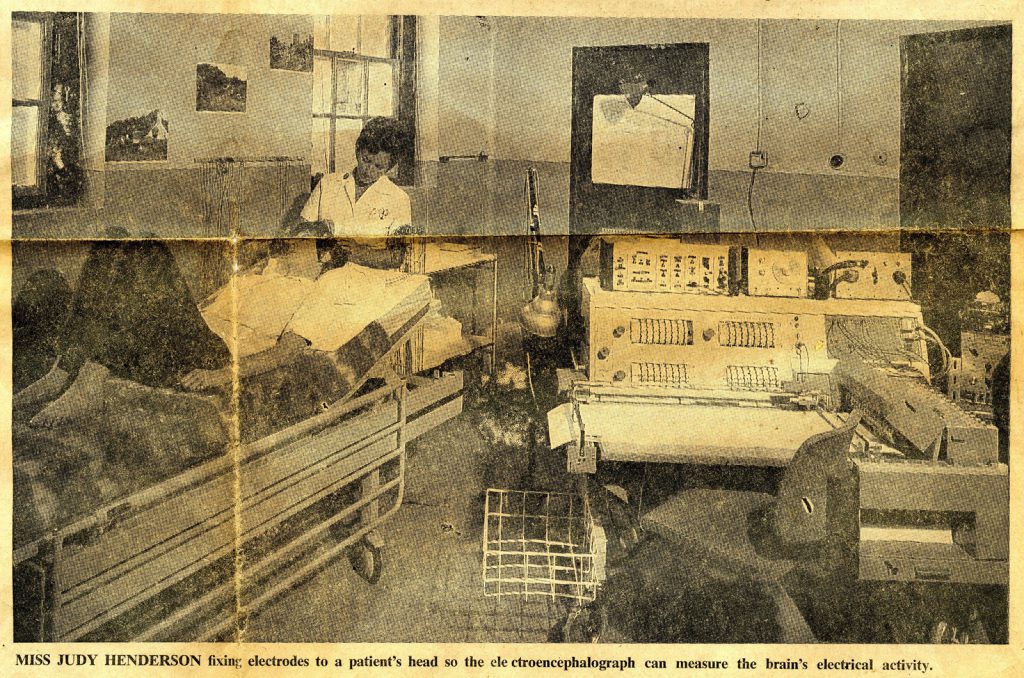
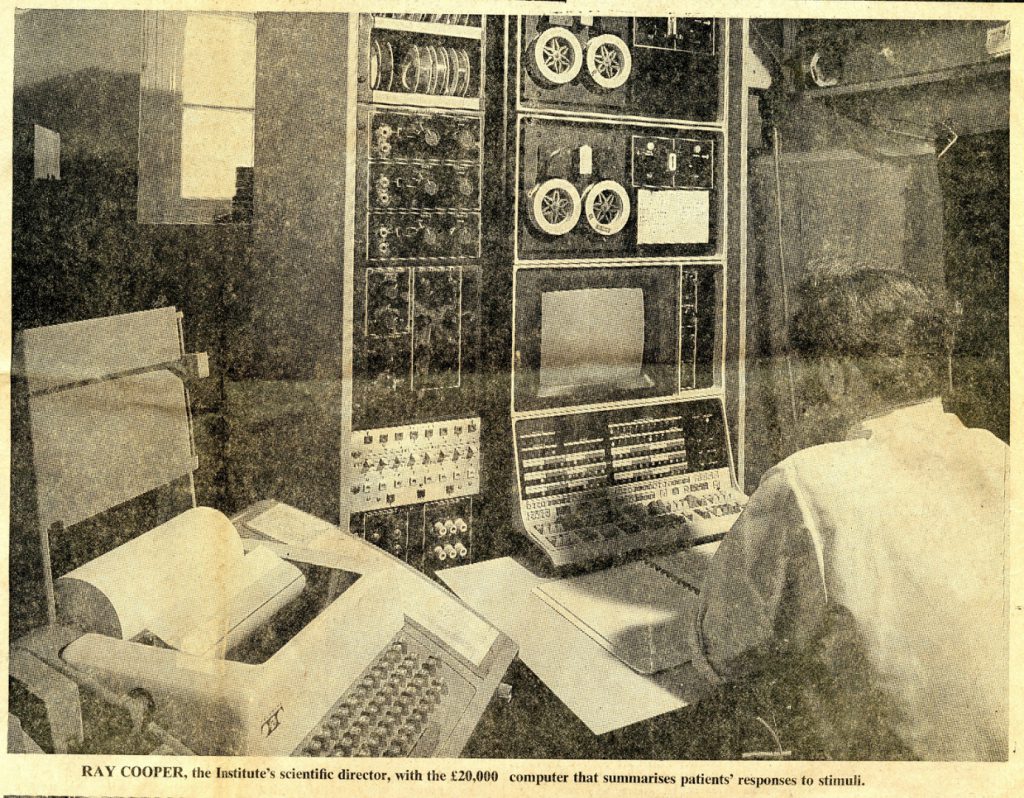
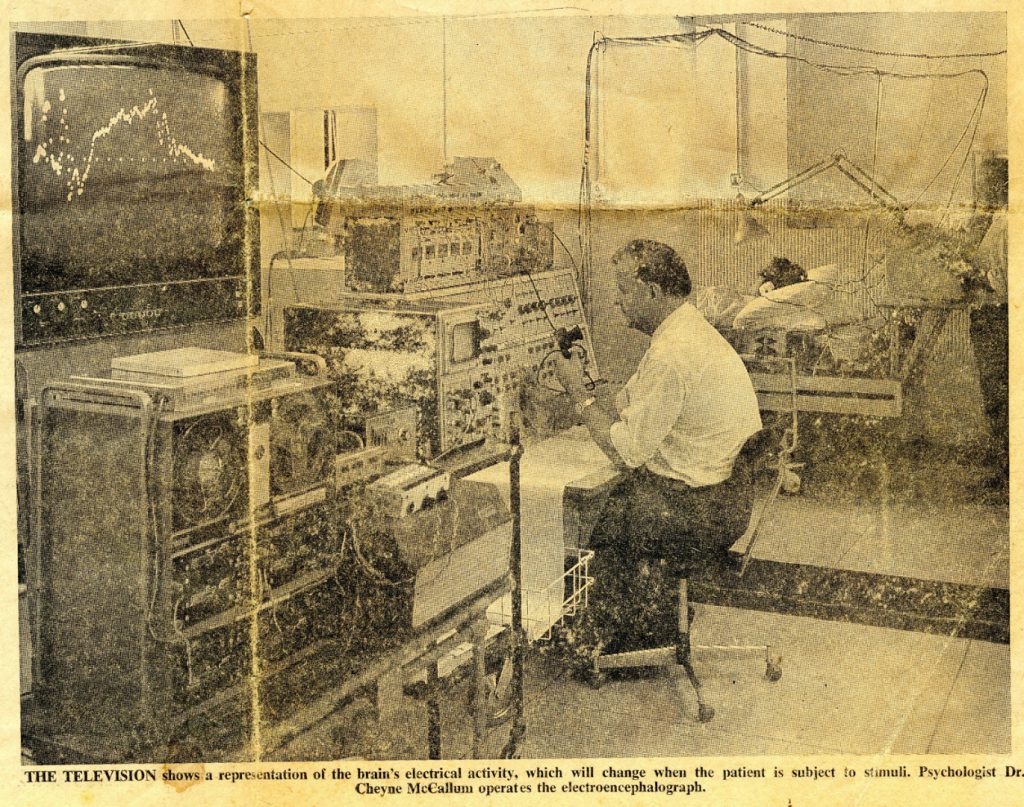
However, rather than focusing on employees such as Henderson, published photographs of the BNI far more commonly identified women as the objects and subjects of neuroscientific research. A typical example of this can be seen in a set of press photographs taken in the laboratories of the BNI in 1970, during a period of intensified media interest about the Institute’s work on computerising the diagnosis of conditions ranging from schizophrenia to chronic migraine. In the first image, besuited neurologist Demetrios Papakostopoulos is shown at the controls of an EEG while an anonymous young woman sits in the next room, constrained by a mass of wires and electrodes (see Figure 4). The image establishes a clear division between male experimenter and female participant, made all the more explicit by their physical separation either side of the dividing wall and curtain.
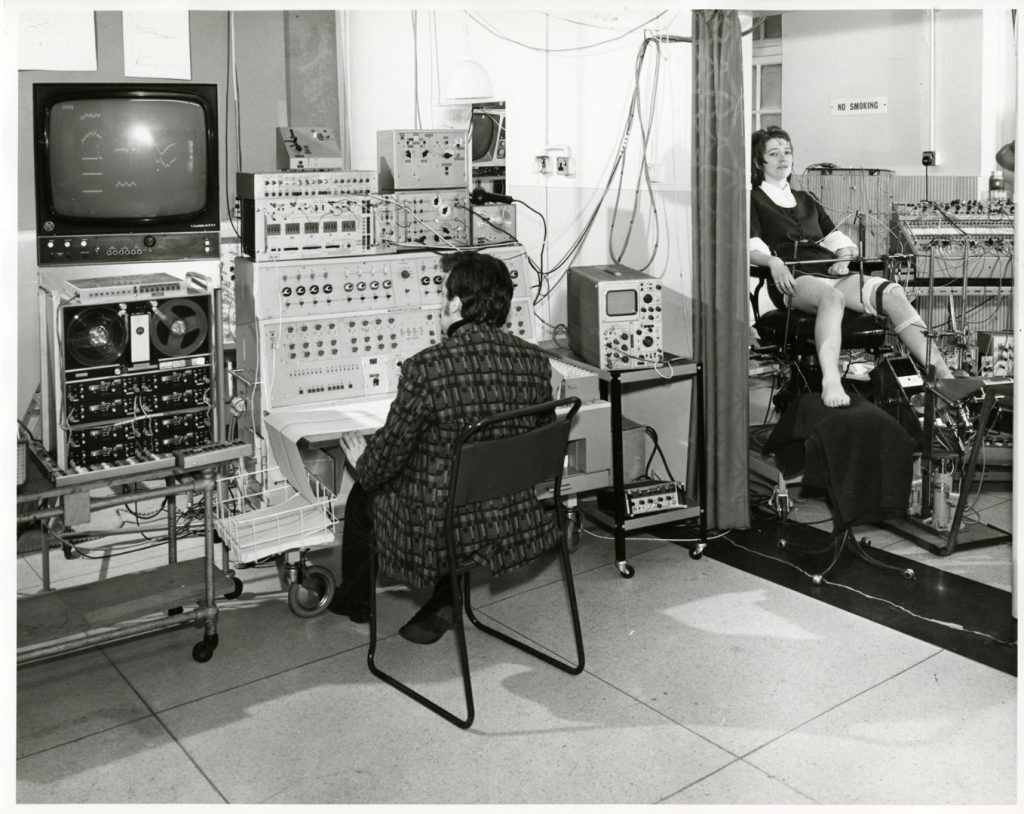
A striking feature of these and similar press shots taken in the BNI’s laboratories during this period is the flexibility with which they were deployed across different newspaper accounts. Rather than depicting specific research practices related to the piece at hand, newspapers would often utilise the same image of a female subject to accompany diverse stories ranging from the EEG testing of juvenile delinquents to new investigations into Parkinson’s disease. While the repeated use of these photographs was no doubt partially the result of constraints placed upon editorial decision-making by tight deadlines and limited resources, the end result was that the image of the passive, restrained ‘Guinea Pig Girl’ – as one 1973 article in the Western Daily Press described such volunteers – became common visual shorthand for neuroscientific power and knowledge.[8]
This bolstering of male authority through depictions of the female body was not a new development in the visual culture of scientific research. Indeed, as Katharine Park has argued (2006, pp 91–120), such strategies can be traced back at least as far as the sixteenth-century, when writers on human anatomy utilised painstaking diagrams of the ‘mysterious’ female body as a way of proclaiming their unique knowledge and expertise. However, photographers visiting the BNI drew inspiration from far more recent sources: namely, visual depictions of new ‘truth-telling’ technologies which emerged in laboratory studies of the human body at the turn of the twentieth-century (see Dror, 1999). Nowhere was this more apparent than in coverage of the polygraph, or ‘lie detector’. Photographs of the polygraph in action frequently opposed the cool, detached male operator with the passive, restrained female subject as a way of staging the triumph of (masculine) scientific reason over (feminine) deception (Bunn, 2012, pp 148–152). This visual model could be applied with ease to the EEG. While researchers at the BNI repeatedly asserted that the recording of brainwaves gave no such insight into domains of truth or falsehood, repeated requests from journalists for demonstrations of the EEG’s ‘mind-reading’ abilities suggested a pervasive connection between electroencephalography and lie detection in the popular imaginary.[9]
This objectification of the female research subject as submissive, restrained and voyeuristically observed inspired some photographers to stage women’s interactions with neuroscientific machinery as a kind of erotic encounter. As Lisa Cartwright (1995, pp 154–159) proposes in her examination of the X-ray in twentieth-century public health films, the power of diagnostic technologies to penetrate the body’s surface and reveal its inner secrets can often be communicated through an eroticised male gaze directed at an exposed female body. This is certainly present in many of the press photographs taken of female subjects within the laboratories of the BNI, which were often framed in such a way as to linger upon parts of the body exposed for experimental purposes, such as blood pressure readings taken from the thigh (see Figure 5). Such images were frequently accompanied by captions that emphasised the methods of physical restraint involved in taking such readings, with young women ‘wired-up’ to machines and kept immobilised for extended periods of time.[10] These kinds of depictions were, of course, far from unique to depictions of neuroscientific research, instead forming part of a post-war ‘mainstreaming’ of erotically-presented female bodies across advertising, celebrity photography and photojournalism (Solinger, 2001, pp 205–209; see also Serra, 2009, p 454; Kozol, 1994, pp 35–41; Goffman, 1976). In photographs of the BNI, however, this employment of the exposed female body served a further purpose, beyond voyeuristic spectacle or advertising strategy: to bolster the truth-telling credentials of neuroscience and its (assumed male) practitioners.
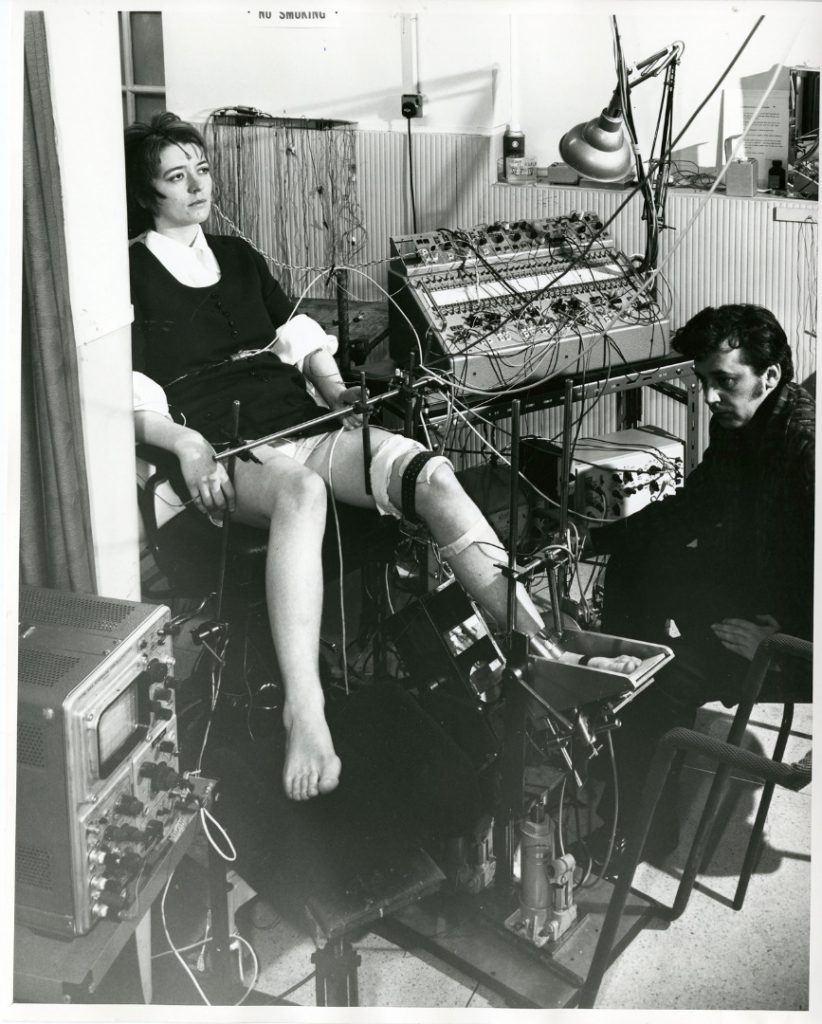
This visual dichotomy between male experimenter and female subject was so pervasive in photojournalistic accounts of the BNI’s work that it even extended to female employees, not just the stand-in models who often populated newspaper images. For example, in a photograph taken by Larry Burrows as part of a 1958 Life magazine story about the BNI’s EEG research programme, Janet Shipton is staged as a participant in an experiment designed to evaluate the effect of strobe lighting on the electrical activity of the brain (see Figure 6). Despite her active involvement in this very research project, neither the image nor the accompanying text frame Shipton as a scientific collaborator. Instead, the article emphasises her family pedigree (as the daughter of ex-Prime Minister Clement Attlee) and her marital status (with her husband, Harold Shipton, employed as an electrical engineer at the Institute). As well as revealing unspoken assumptions among photographers, writers and editors about the appropriate role of women in neuroscientific research projects, this positioning of Shipton through the familial labels of ‘daughter’ and ‘wife’ indicates towards another prevalent framing of women’s labour within the BNI’s laboratories.

Part II: Working wives
https://dx.doi.org/10.15180/181003/004‘She helped to pick up the pieces’
As well as its burgeoning reputation as a centre for scientific and technological innovation, in the immediate post-war years the BNI developed something of a track-record for romantic matchmaking, as several of its laboratory partnerships blossomed into marriages. This was particularly evident in 1947, a year which saw the marriage of Janet and Harold Shipton – who celebrated their wedding at Chequers alongside most of the Attlee Labour Cabinet – as well as that of Vivian Dovey and William Grey Walter.[11] While this romantic dimension of the BNI’s history has attracted some attention (see Hayward, 2001), the exact weighting this takes in biographies of the Institute’s staff depends heavily on their gender. For instance, in the ‘official’ institutional history of the BNI, written by Cooper and Bird (1989, pp 54, 60), Walter’s romantic life is relegated to secondary ‘colour’, ranking alongside descriptions of his hobbyist interests in glider planes and deep-sea diving. Meanwhile, the only significant entry on Dovey focuses entirely on her ‘devotion’ to her husband, particularly her ability to ‘pick up the pieces’ following his involvement in a serious road accident in 1970.
Post-war documentary photographers demonstrated a consistent interest in these laboratory romances while covering stories at the BNI and similar institutions, making deliberate attempts to capture the ‘working couple’ in action. This fascination was informed by contemporary discussions about new ‘companionate’ or ‘democratic’ models of marriage in post-war Britain, a vision of matrimony attuned to the shifting realities of the labour market in which husband and wife were conceptualised as equal partners within an interdependent team, pursuing shared goals and objectives. However, as Penny Summerfield (1994, pp 59–62) and Marcus Collins (2003, pp 117–133) have proposed, the reality of the companionate marriage was often far from idyllic, as spouses struggled to reconcile new desires for equality with traditional divisions of gendered authority. This potential disruption at the heart of middle-class domestic life proved a popular topic of interest in picture magazines such as Life and Picture Post, whose photo-essays frequently sought to both explore the rising prominence of women in paid employment and public life, while also offering reassurance that these new roles would be contained within conventional expectations of domesticity, maternity and wifely duty (Kozol, 1994, pp 156–169; Solinger, 2001, pp 202–209; Gardener, 1993, pp 45–64). The laboratory couple of the BNI provided a perfect example for these kinds of stories: a ‘modern’ form of romantic collaboration that was nonetheless structured by hierarchical and strictly gendered understandings of labour.
The BNI Papers contain two sets of photographs depicting the Walters at work in the laboratories of the Institute which neatly bookend the span of their romantic relationship (meeting in 1942, marrying in 1947, and separating in 1960). The first photograph of the pair, taken by an unnamed colleague in 1943, indicates an embryonic visual language of gendered authority that would become increasingly apparent in later depictions (see Figure 7). Considering the lack of control over the photographic field, particularly the daylight which almost entirely engulfs Dovey’s face, the photograph appears to be a hastily-arranged ‘snapshot’ for internal recording and circulation, rather than a formally-posed press image. As such, the photograph constitutes an ambiguous middle-ground, caught somewhere between a self-conscious performance of scientific labour and a candid glimpse into the practical division of laboratory work.
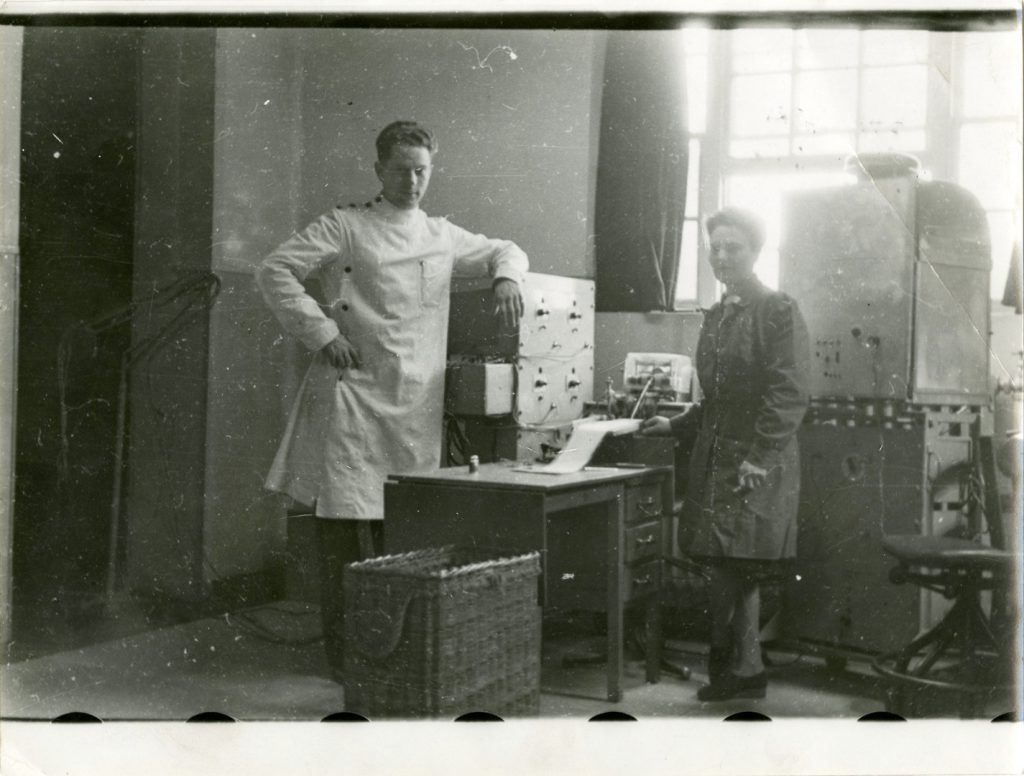
In the photograph, Walter and Dovey stand either side of an early EEG prototype. Walter stands to the left of the shot, dressed in a neat, buttoned-up lab-coat, his right hand on his hip, his left arm draped across the machine’s metal casing. On the right stands Dovey, dressed in dark colours, with one hand resting on the EEG’s pen-writer and the other holding a tool. This relative placement of the two researchers’ bodies seemingly adheres to what sociologist Erving Goffman (1976, pp 32–37) has termed ‘function ranking’: the visual delineation of executive and supportive roles in depictions of male-female collaboration. Walter’s authority is here bolstered by his commanding posture and his cradling of the machine that he built and developed; meanwhile, Dovey’s more marginal position in the photograph and her alignment with the pen-writer emphasise her secondary role as the ‘technician’ and ‘interpreter’ to Walter’s technological creations.
While the early date, limited audience and semi-improvised staging of the photograph do not suggest any purposeful or explicit framing of the couple as romantically involved, this image nonetheless indicates towards the profound influence of domestic norms on the practical division of laboratory labour. As Clare Langhamer (2017, pp 11–12) and Pnina Abir-am and Dorinda Outram (1987, pp 10–12) have argued, this blurring of the boundaries between ‘woman’, ‘employee’, and ‘wife’ required no underlying romantic relation to function; it merely required a belief in an inherently feminine set of skills that naturally suited women to subordinate positions of technical and emotional support, both in the workplace and within the home. These conventions also demonstrated the lasting impression that domestic service left on the career trajectories of British women in the post-war period. Despite the near total collapse of the occupation that had been the major employer of British women for much of the nineteenth- and early-twentieth-century (declining from 41 per cent of the female workforce in 1891, to 24 per cent in 1931, and finally to around five per cent by 1951), new opportunities for work continued to be impacted by domestic service’s culture of female servitude and patriarchal authority (Delap, 2011, pp 11–12; Todd, 2005, pp 22–23, 148–149).
Looking ahead to the next two images of the Walters, a pair of more deliberately posed shots taken by photographer Brian Brake in 1956, it is revealing to see that many of the hastily arranged elements of the earlier snapshot are here formalised, extended and exaggerated to form a more clearly self-conscious language of gendered labour (see Figures 8 and 9). In many ways, Brake, whose style was influenced both by an apprenticeship as a studio portrait photographer and his later work as a documentary filmmaker with the New Zealand National Film Unit, was the ideal person to capture both the idiosyncratic intimacies and broader social relevance of the Walters’ working relationship (see Mitchell, 2010; Doss, 2001, pp 11–17). In both photographs, the pair are shown working in the operating theatre of the BNI, examining read-outs from an EEG. William Grey Walter stands, adjusting the machine’s dials, while Vivian Walter sits, eyes cast downwards, observing the readings with a pen in hand. Thus, the hierarchical distinction between male ‘brain worker’ and female ‘technician’, glimpsed in the earlier image, is here solidified through a more rigorous control of the photographic field and the bodies within it. It seems revealing that, in both images, Vivian Walter is positioned quite literally in her husband’s shadow. The one key difference, however, is Brake’s attempt to combine this depiction of labour with a sense of proximity and intimacy. Unlike the 1943 snapshot, in which the practicalities of the couple’s respective roles keep them isolated on either side of the EEG, here they are brought together in close confines. As such, Brake’s images depict the Walters’ partnership as at once personal and professional, romantic and scientific, and thus attempt to merge the realms of laboratory and domestic authority.
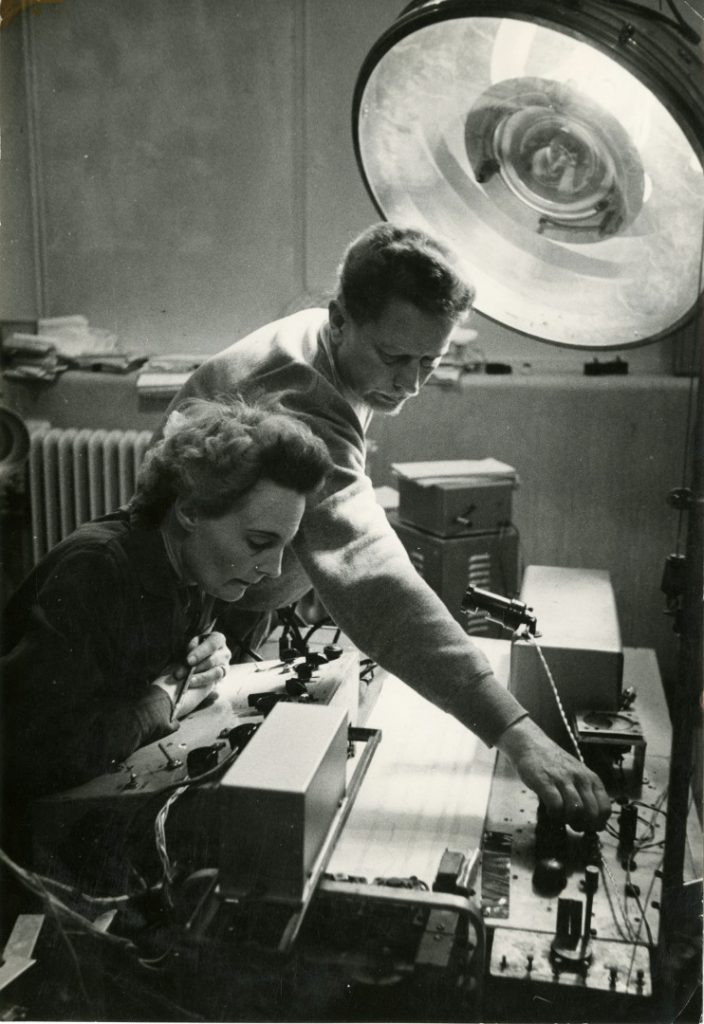
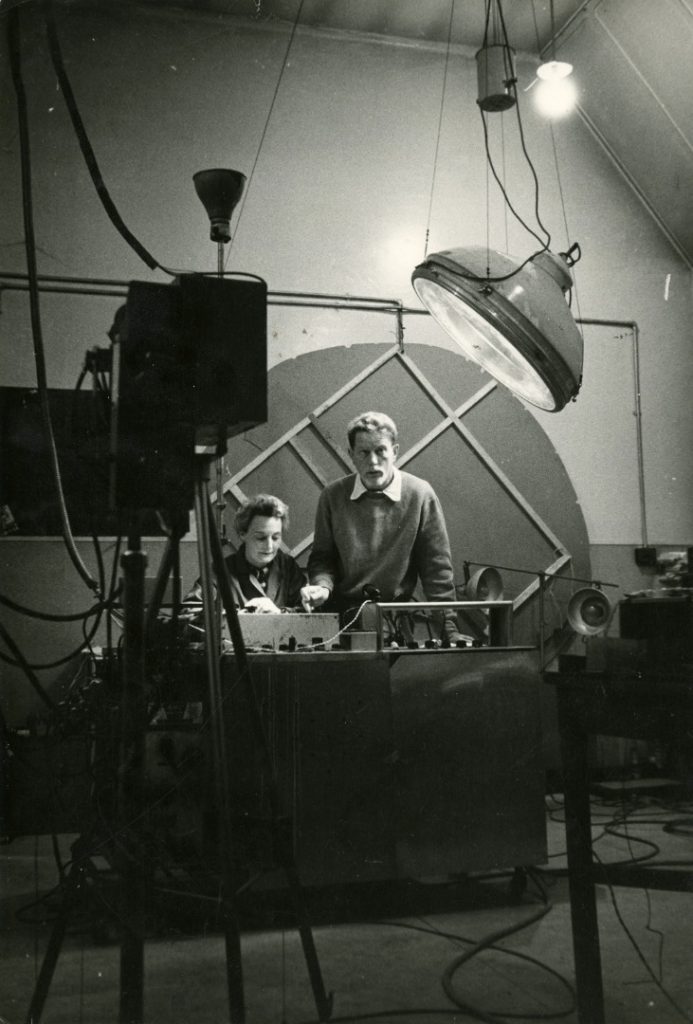
This domesticated framing of the female scientific worker comes into sharper relief still when compared with the very different way in which male collaborative relationships were visually presented. One illuminating example is a photograph of William Grey Walter and Ray Cooper, taken in 1964 (see Figure 10). In this image, the men look down at the readings of a 16-channel EEG: Walter sits on a stool, his hand on his chin, while Cooper stands on the opposite side, one hand on his hip and the other reaching forward to adjust the machinery. Unlike Brake’s depictions of the Walters as a working couple, the framing of this photograph instead suggests a collaborative relationship defined by mutuality and equality. Both Walter and Cooper adopt the poses of skilled ‘brain work’: Walter in the classic ‘thinking scientist’ pose, Cooper confidently engaging with the machinery in a manner which strikingly recalls the young Walter of 1943.[12] Such an image suggests that male researchers were less vulnerable to hierarchical visual framings than their female colleagues. While men were frequently coded as peers, even when, as in the case of Walter and Cooper in the 1960s, significant differences in seniority existed between them, women were far more likely to be depicted in ways that linked their skills and expertise to notions of femininity and familial duty.
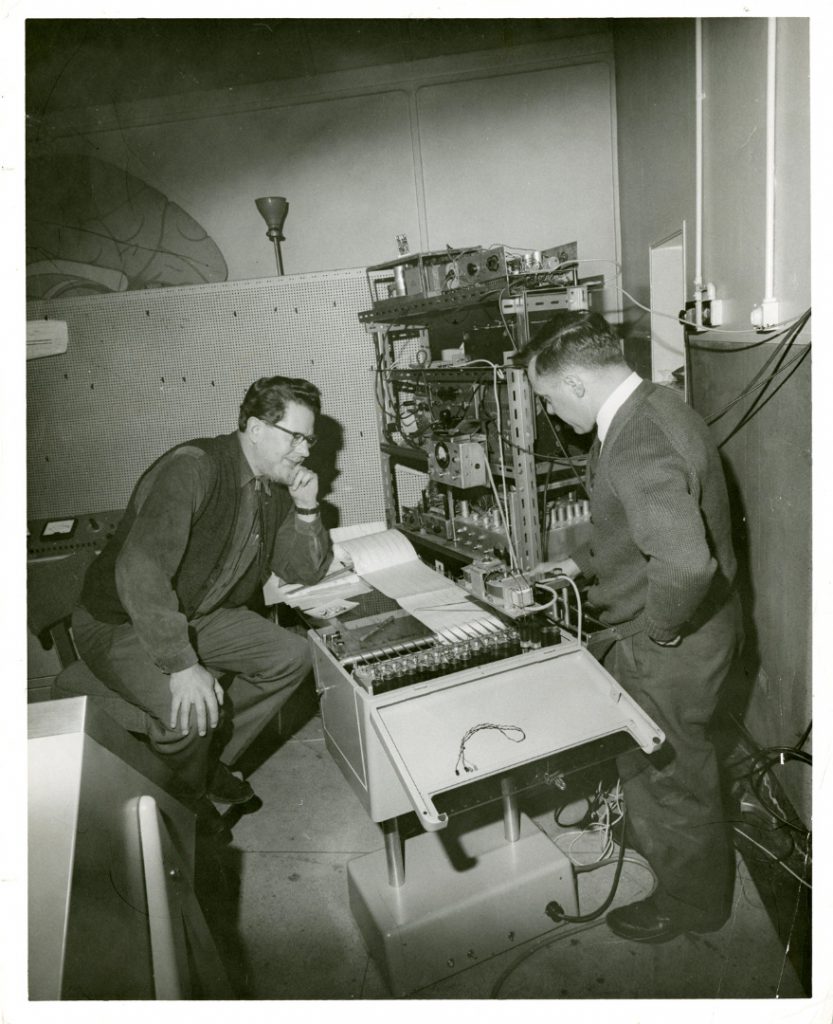
Part III: The perils of networking
https://dx.doi.org/10.15180/181003/005‘We are both feminine’
Photographs of women employed at the BNI also provide an alternative perspective on one of the Institute’s main attractions for historians of science and technology: its involvement in the first wave of British cybernetics. Coined by American mathematician Norbert Wiener in 1947, cybernetics refers to the study of feedback, control, and communication systems ‘whether in the machine or living tissue’, integrating approaches from biology, physiology, mathematics, engineering, psychology and the social sciences (Wiener, 1948). In Britain, this field developed a distinctly psychiatric orientation, as practitioners utilised cybernetic modes of investigation to explore the capacities and vulnerabilities of the human mind. William Grey Walter is often credited as a key promoter of this approach, particularly through his construction of electromechanical models of the brain such as his Machina Speculatrix, or robot tortoises (see Figure 11) (Hayward, 2001, pp 622–624; Pickering, 2010, pp 41–54).

The distinctive kind of cybernetics practiced by Walter and others at the BNI entailed a peculiar way of thinking about the interactions between humans and machines, one that privileged the flow of information between them rather than their respective material forms. As such, through a cybernetic lens, the human actor is less a unique and inimitable entity than a roughly comparable organic counterpart to the machine. In turn, this requires all those involved in cybernetic research, including the supposedly ‘neutral’ experimenter, to be considered part of an interdependent and mutually transformative circuit (Hayles, 1999, pp 62–65; Hayward, 2001, pp 629–630). This perspective was reflected in many of the experimental designs and set-ups developed within the BNI’s laboratories, in which human brains were perceived as ‘wired’ into networks that blurred the boundaries between the organic and the mechanical (see Figure 12).
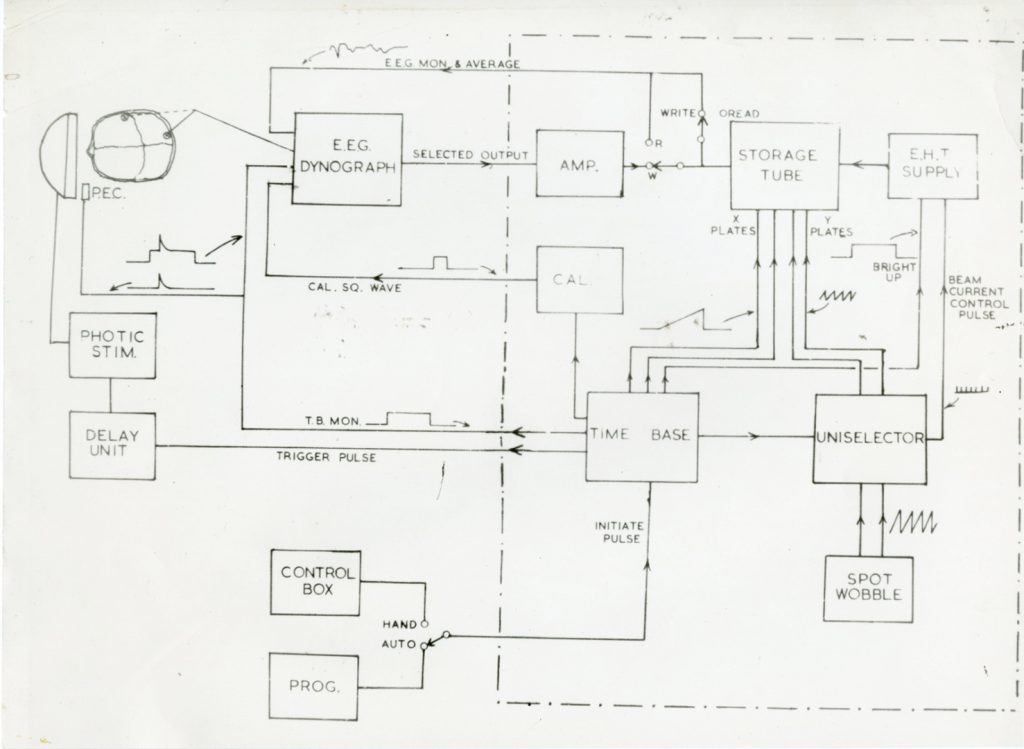
Photographs of women’s labour at the BNI provide an insight into some of the complex and ambiguous implications of this cybernetic world-view. As N Katherine Hayles (1999, pp 283–291) and Andrew Pickering (2010, pp 383–391) have proposed, cybernetics has both liberating and anxiety-inducing implications. On the one hand, the field’s dissolution of traditional notions of order and hierarchy, combined with its emphasis on communality and interdependence, has the potential to undermine traditional distributions of power; on the other hand, cybernetics exposes the instability of concepts such as individuality and autonomy, and necessarily entails the incursion of machines into domains once considered exclusively ‘human’. The photographs of the BNI Papers, however, suggest that these potential benefits and pitfalls did not adhere to a logic of equal opportunity. While depictions of cybernetic research had the potential to absorb, engulf and anonymise the contributions of women, those of their male counterparts proved far less vulnerable to the totalising logic of the circuit.
The gendered implications of the cybernetic world-view can be rendered in stark contrast by comparing two photographs of EEG research at the BNI. The first, taken in 1964, depicts William Grey Walter at the helm of a complex network of machinery (see Figure 13). Sitting in front of a 16-channel EEG, Walter’s left hand holds a pen over the brainwave record while his right hand adjusts a dial on the control panel. This multi-tasking emphasises Walter’s skill and dexterity; while previous photographs depicted the technical and intellectual labour of neuroscientific research as belonging to separate, and strictly gendered, roles, Walter is here shown balancing the duties of both ‘brain worker’ and ‘technician’ with apparent ease. This dual labour is revealing on two levels. Firstly, it provides a visual performance of Walter’s rare genius and polymathic ability, a reputation already established through his growing number of television and radio appearances during this period, as well as his success as a popular science writer.[13] Secondly, considering the breakdown of his personal and professional relationship with Vivian Walter four years previously, the photograph perhaps provides an insight into a more practical reformulation of his laboratory routines as a solitary researcher. Ultimately, this performance of mastery ensures that Walter remains the primary visual point of reference in the photograph, despite the complex and potentially overwhelming mass of circuitry that surrounds him.
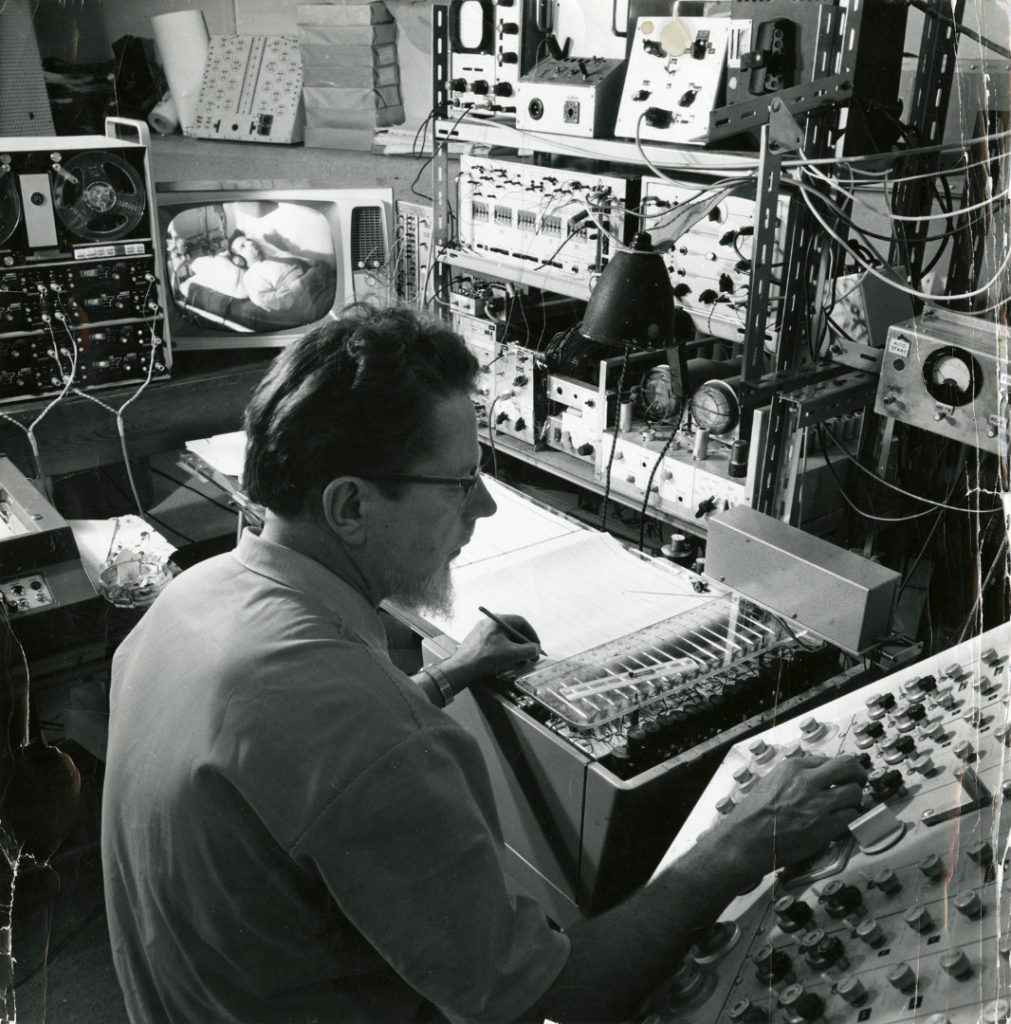
The second photograph, taken by Bristol photographer Desmond Tripp, depicts Janet Shipton sat in front of a six-channel EEG, conducting research with a similarly complex experimental circuit (see Figure 14). To her left is a reclining male subject, his face obscured by a stroboscopic lamp; on the opposite side of the room stands a 22-channel toposcope, a machine designed to provide a real-time visual map of the subject’s brain responses through the patterned illumination of light bulbs; to her right is a video camera, positioned to record the entire experiment. However, unlike the previous photograph of Walter, it would be difficult to argue that Shipton is the primary visual focus here: indeed, her body is partially cut off by the frame. Instead, she is given no greater visual presence than the anonymous male subject beside her or the pieces of complex machinery positioned around the laboratory. The relatively equal spacing given to each constituent part of the experimental circuit – the operator, the subject, the EEG, the toposcope, the video camera – underscores the networked totality of cybernetic research rather than Shipton’s unique position at its helm. Thus, while the depiction of Walter remains a relatively conventional ‘portrait’ of the scientist at work, Shipton’s photograph has more in common with circuit diagrams and unpopulated images of experimental set-ups, transmitting a cybernetic worldview in which man (or, more accurately, woman) and machine are almost indistinguishable.
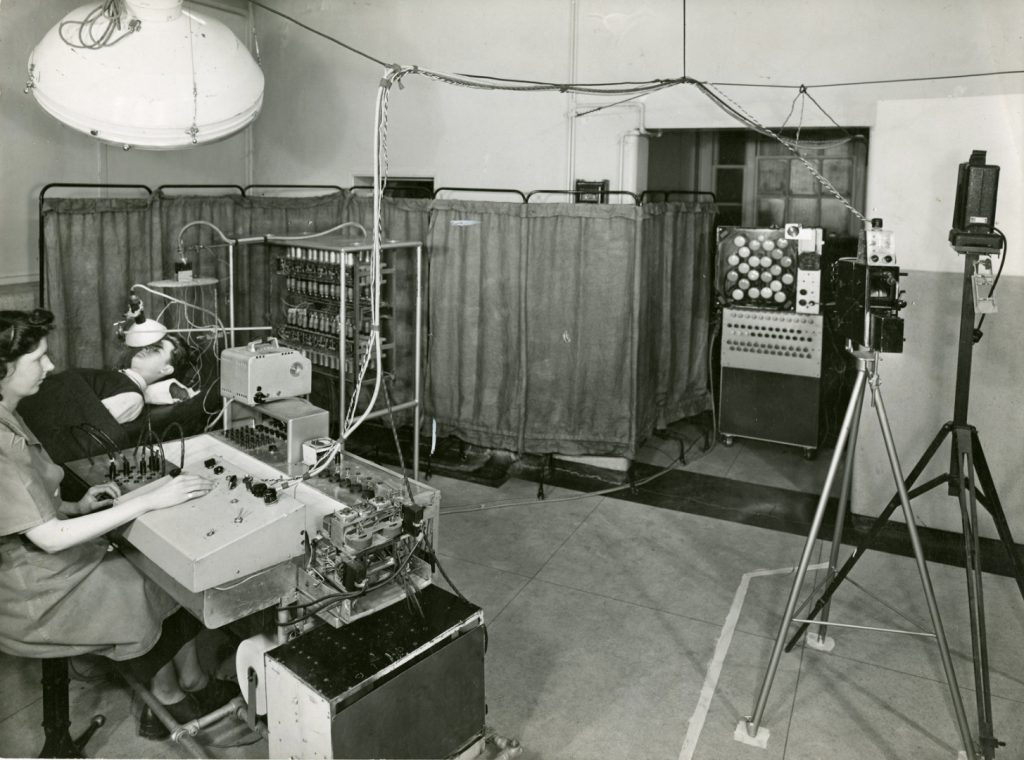
This uneven application of the cybernetic perspective – rendering women’s labour in mechanistic terms while preserving the work of men as abstract, intellectual and irreplaceably ‘human’ – left women in scientific occupations particularly vulnerable to marginalisation and even replacement via automation. For example, Walter’s research became increasingly reliant on feminised mechanical substitutes for his female colleagues as the 1950s progressed. Nowhere was this more apparent than in his creation of ANNIE, an automatic wave analyser that organised brainwave patterns into distinctive alpha, beta, theta and delta frequencies. Acting as assistant and interpreter in Walter’s EEG work, ANNIE began to encroach upon the role that Vivian Walter had once occupied, as depicted in earlier photographs of the pair’s scientific partnership (Hayward, 2003, pp 623, 631). Walter’s attribution of distinctly feminine identities to such machines did not pass unnoticed by his colleagues and peers. As Mollie Brazier, a pioneering electroencephalographer working in Massachusetts General Hospital in Boston, noted: ‘I am considering having ruffled curtains of white Organdie for my room and Annie’s just to show that we are both feminine.’[14] Displaying once again the tendency to render in erotic terms the engagement of women with neuroscientific machinery, Walter rejected the possibility of ANNIE being surrounded by demure white cotton. ‘I have a leaning for black satin myself,’ he replied, ‘with lace peepholes tactically disposed!’[15]
As the framing of Shipton’s labour demonstrated, the eagerness of photographers and editors to capture the cybernetic totality of the BNI’s experimental programme could often lead to women being relegated to the very edges of the frame. However, this desire could also see them excluded entirely: the BNI Papers contain no photographs of women engaged in research activities after 1956. This in many ways foreshadows what Marie Hicks has identified as the growing ‘masculinisation’ of technological labour in the 1960s and early 1970s. With computer-based work growing in both social prestige and economic importance during this period, employers increasingly ignored the ranks of skilled, experienced women who had overwhelmingly occupied these roles since the Second World War and instead filled positions with (frequently less qualified) male candidates (Hicks, 2017, pp 187–188). At the BNI, this decline in the status of women engaged in research appeared to set in at a much earlier date: Hutton died in 1956 following a long illness; Shipton moved to the United States in 1958 when her husband took up a position at the University of Iowa; only Vivian Walter continued to conduct research at the BNI, co-authoring publications into the 1970s.[16] The glorious technological future heralded by photographers visiting the BNI, then, was a future in which women were an increasingly scarce sight.
Conclusions: histories of women’s labour, photography, and the museum
https://dx.doi.org/10.15180/181003/006The photographs contained within the BNI Papers can offer much to historians of twentieth-century neuroscience: glimpses into everyday practices of knowledge-making, self-conscious performances of scientific power and authority, speculative imaginings of technological advancement. Yet alongside these uses, which sit more or less comfortably with conventional narratives of scientific progress, these photographs can also reveal some of the disempowering ways in which women’s labour was framed, understood, and communicated to the outside world. Ultimately, these visual framings – of passive subjecthood, of wifely duty, of machine-like drudgery – are united by a single, dominant concern: agency. Each frame acts to reduce the historical agency of women employed at the BNI, either through an outright denial of an active role for them within the Institute’s research programme, or else by diluting their contributions through allusions to the private, the domestic, and the mechanical.
However, this is not to say that photographs of the BNI are blunt tools of misogyny, good only for hostile acts of academic deconstruction. Indeed, if, as current historians of photography contend, the meanings attributed to photographs are intrinsically tied to their physical, material and spatial circumstances, then perhaps more empowering possibilities for these images can be found in new techniques of historical analysis and public display (see McCredie, 2015; Ginsburg, 2016). For historians of science, the creation of new strategies to deal with the archival erosion of women remains a challenging proposition, one that requires a delicate balancing act between championing individual autonomy and recognising the coercive nature of gender norms and social structures (Lee and Logan, 2017). While women engaged in scientific labour certainly need to be elevated to the status of protagonists in their own histories – and not merely confined to the closing comments of biographies and obituaries dedicated to their more famous male colleagues – narratives of scientific triumph and achievement against the odds can only go so far. Equally important are those stories of wasted potential, limited opportunity and squandered talent (see Hicks, 2017, pp 232–236). Photographs that exist outside of familiar and comforting narratives of scientific advancement, depicting instead the mundane realities of everyday life within the laboratory, might provide a useful starting point for such a project.
While interrogating women’s agency through the medium of photography is difficult enough for the historian, it is a challenge of an entirely different order for the museum curator. How might a critical approach to photographic depictions of gendered labour play out in the galleries and exhibition spaces of the museum? How might curators not just increase the quantitative representation of women in depictions of scientific activity, but also encourage visitors to consider the unspoken rules and assumptions that can guide these very depictions? Any drive to encourage debates about the relationship between gender, scientific research and the photographic image must be accommodated within the daily realities of museum curation, a role that is perpetually caught between the desire to produce challenging and thought-provoking content and an inevitable constellation of political, institutional, bureaucratic, temporal, spatial and budgetary constraints (Edwards, 2001, pp 185–186).
Some strategies for deploying photography in a more critical fashion can be found in the recent findings of the photoCLEC (Photographs, Colonial Legacy and Museums in Contemporary European Culture) project, led by historians Elizabeth Edwards, Susan Legêne, and Sigrid Lien. Investigating the ways in which photographs have been utilised in museums to interrogate the European colonial past, researchers conducted case studies of display strategies that successfully encouraged visitors to look beyond the neutral façade of the photographic image and consider deeper, and often more uncomfortable, levels of political, social and economic meaning. These included the proximate grouping of photographs from different periods and locations to encourage visitors to compare, contrast and forge connections between them, artistic collaborations such as installations which deploy photographs outside of the neutral and authoritative register of the museum display to draw attention to competing and conflicting interpretations, and the inclusion of original photographic prints, negatives and reproductions to remind visitors of the physical materiality of the photograph as a historical object (photoCLEC, 2012; see also Edwards, 2010; Tinkler, 2011; Shields, 2015). However, as Elizabeth Edwards and Matt Mead (2013, pp 22–23) have noted, these ambitious experiments in display practices rarely survive the transition to permanent collections. Far more entrenched obstacles regarding the use of photographs in museums – ambiguous collection and retention policies, overstretched archival resources, the relatively marginal status of photographic expertise in museological training courses and job specifications – must be addressed before any profound changes in display practices can be expected (see also Edwards and Morton, 2015, pp 7–14).
This search for both ground-level and institutional solutions has consequences that extend far beyond the walls of the museum and archive. Despite next year marking the seventieth anniversary of the BNI’s founding, examinations of gendered inequality at the Institute show little sign of declining relevance. In 2017, despite the constitution of the British workforce rapidly approaching gender parity, just 23 per cent of core STEM (Science, Technology, Engineering, and Mathematics) positions are held by women (Office of National Statistics, 2018; WISE Campaign, 2017). These low levels of recruitment, retainment and career advancement among female science graduates have proven ‘a persistent puzzle’ for activists and policy-makers, a problem to which numerous causes have been attributed. These range from the lack of female role models and mentoring programmes, to hostile workplace environments and cultures, to disproportionate allocations of administrative, pastoral and teaching duties among female members of staff (Bilimoria, Lord and Marinelli, 2014; Bilimoria and Liang, 2014).
Given the complex and deeply embedded nature of these obstacles, which simultaneously demand political, social and legislative modes of redress, historians and curators might well feel powerless to contribute to attacks on the systematic underrepresentation of women in science. However, there is one commonly identified contributing factor that historical and museological expertise is particularly well-suited to address: the ‘masculine’ culture of scientific and technological research, which establishes the ideal practitioner as male and signals to prospective female candidates that they do not belong within the laboratory (Cheryan et al, 2017; van den Brink and Stobbe, 2014). Photographs of women working at the BNI, with their disempowering frames of reference, serve as an important reminder that such cultures are sustained not just through contemporary workplace practices, but also through acts of visual and historical transmission. By presenting past scientific achievements as stories of exclusively male enterprise, and casting women in largely incidental, unremarkable and easily replaceable roles, such images work to culturally enforce the marginalisation and exclusion of women within contemporary sites of research. Yet, by mobilising and displaying these photographs in new and unexpected ways, historians and curators can help to foster a critical language of gender and representation in images of scientific progress, thus transforming potentially disempowering artefacts into new platforms for dissent and critique. The alternative, it seems, is the continued devaluation of women’s labour within the archival record, impoverishing not just our view of the scientific past, but also the ethical and social possibilities of the scientific future.
Acknowledgements
The author gratefully acknowledges the support of the Wellcome Trust, who funded this work through a Secondment Fellowship (208465/Z/17/Z). The author would also like to thank the Centre for the History of the Emotions, particularly Dr Helen Stark and Dr Jennifer Wallis, for their encouragement and support.
This article would not have been possible without the invaluable guidance of the Science Museum’s Archive Collections and Library Teams, with special thanks due to Beata Bradford, Amanda Johns, Hannah Nagle and Prabha Shah. The author would also like to thank Adam Boal, Tim Boon, Jessica Bradford, and Laura Humphreys for their support throughout the secondment. Many thanks are also due to the article’s reviewers for their constructive and insightful comments.
Finally, the author would like to acknowledge the generosity of the copyright holders who granted permission to use their images in this article, with particular thanks to Jeff Bolitho, Russell Burrows, the Gazette Series, the Museum of New Zealand Te Papa Tongarewa, and David Riley.
Tags
Footnotes
Back to text
Back to text
Back to text
Back to text
Back to text
Back to text
Back to text
Back to text
Back to text
Back to text
Back to text
Back to text
Back to text
Back to text
Back to text
Back to text



